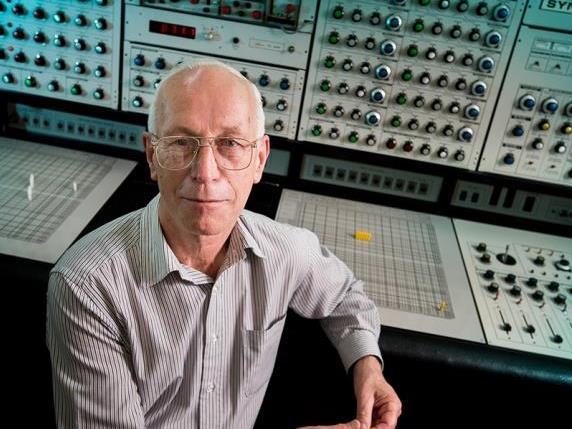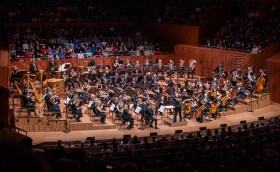Image: Les Craythorn with the Synthi 100; photograph courtesy Melbourne Recital Centre
As a concert experience, watching a synthesiser ‘perform’ on stage might seem a lost cause – certainly I had my doubts before this occasion – but I went into this hour-long recital with an open mind.
On stage and lit in lurid green and pink was the Synthi 100 in all its glory, lovingly restored by its curator and recently retired technical officer of the Melbourne Conservatorium of Music, Les Craythorn. The instrument, an Electronic Music Studios (EMS) Synthi 100 modular synthesiser (approximately measuring 3 metres long by two high), is very rare indeed. Only 40 were produced and it is thought that but three remain of which this, the property of the University of Melbourne, is one. Stockhausen owned one as did Xenakis. Its voice, or one of them, is more widely known as being used in the theme music to Dr Who. First built in London in 1971, the instrument does not use patch cables nor does it require a keyboard, instead featuring a pin matrix system allowing far greater subtlety of sound adjustment. It was the centre of a body of music experimentation that sought to ‘free tone-art’ (Grainger’s words applied to his earlier Theremin compositions) of regular pitch and beat.
Attended by enthusiasts from all over the country, the concert was in six parts, with informative spoken interludes by Les Craythorn, and presented both pre-programmed and performed works, some more demonstrations of the instrument’s capabilities. Notable were Peter Tahourdin’s first-rate composition for the instrument, Three Mobiles (1973-74) with its spectacular wave-like crashes and delicate pointillistic textures, and Percy Grainger’s Free Music Nos 1 and 2 (1937) both originally composed for Theremin; the second work’s graphic score is engraved into the wooden walls of the Salon, and received here its first ‘live’ performance in the room, itself an important event in the history of the Melbourne Recital Centre.
For the final work, Les Craythorn and the Synthi 100 were joined onstage by members of the experimental chamber ensemble, Three with Peter Neville, percussion for a untamed, energetic, interactive improvisation in homage to former jazz colleague, Brian Brown. The combination of the Synthi 100 and performers provided a highly engaging ten minutes of listening, during which the musicians contributed hitherto un-witnessed techniques including bike horn held against the surface of a suspended cymbal and bowed trombone. The tribute was heartfelt and warmly appreciated by the large audience of enthusiasts. A unique experience, this was well worth hearing.
Rating: 3 stars out of 5
Synthi 100 in Concert
Saturday, 23 April, 2016
Salon, Melbourne Recital Centre
Presented by the Melbourne Recital Centre and the Melbourne Conservatorium of Music
Synthesiser: Les Craythorn
Percussion: Peter Neville
Guitar: Ken Murray
Trumpet: Joel Brennen
Trombone: Don Immel





